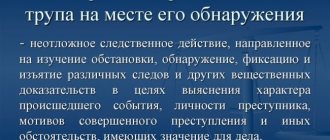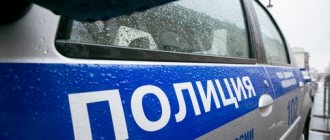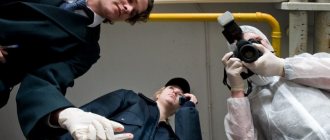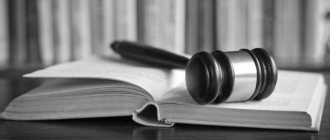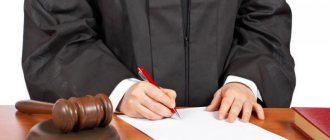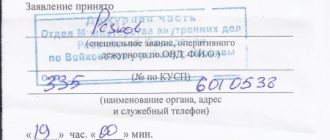The protocol for examining the scene of a theft records the progress of the operational investigative team at the crime scene.
Dear readers! To solve your specific problem, call the hotline or visit the website. It's free.
8 (800) 350-31-84
One of the main types of theft of other people's property is theft. This type of crime is very diverse in nature: there are thefts from apartments, shops, warehouses, etc.
What is a theft scene investigation protocol?
Information about theft usually comes from apartment residents or officials (store director, security guard, etc.). An operational-investigative team consisting of operatives, a criminologist, a dog handler, and a local police officer must go to the crime scene as quickly as possible. Its tasks include inspecting the crime scene, detecting material evidence, seizing it, finding traces of the criminal, etc.
During the group's work, eyewitnesses and potential witnesses are interviewed. If possible, a hot search is organized.
The results of the work of the operational investigation team at the crime scene are necessarily recorded. They are reflected in the official document that is attached to the case: a protocol for examining the scene of the incident. It is necessary in order to attach the found evidence and other evidence to the case, and so that they acquire legal force.
Premises inspection procedure
As a rule, several people are involved in the inspection procedure of the premises. All their data must be included in the inspection report of the premises.
There is no strictly regulated, legally approved procedure for inspecting the premises. Typically, such an inspection occurs for a specific purpose, for example, checking the technical condition, electrical equipment, communication networks, monitoring compliance with fire, environmental safety rules, etc.
Therefore, not one person, but several (at least two) are involved in the process, that is, a special commission is created. It often includes representatives of supervisory departments and government agencies, including engineers, technicians, and experts. This approach ensures the objectivity of the inspection and the reliability of the commission’s conclusions.
Information contained in the protocol
During the inspection of the scene of the incident, it is necessary to solve a certain range of practical goals and objectives, which are included in the protocol. Among them are:
- how the thief entered and left the premises: are there any signs of forced entry into the premises or was a key used, etc.;
- what weapons he used to penetrate;
- whether the offender acted alone or as part of a group;
- collecting information about a criminal or a group of people: their gender, age, etc.;
- drawing up an inventory of the stolen property;
- is there evidence that the criminal knew about the location of the valuables;
- were there any negative circumstances that confirm the staging of the theft (for example, to conceal another crime, accuse an innocent person of theft, or to send the investigative team on a false trail);
- time of the theft (if the exact time could not be determined, then the estimated time range is indicated).
The investigator who is authorized to conduct the theft case is responsible for preparing the protocol.
The information contained in the document must meet the principles of reliability and comparability.
An important step is to search for traces of the criminal : fingerprints or teeth, clothing, traces of burglary tools or shoes, personal belongings forgotten by him, etc. For this, the behavior of criminals in the room is modeled.
A special feature of the theft protocol is the mandatory presence of the owner of the apartment or non-residential premises or the tenant. They must assess what has changed in the environment of the premises after the theft and point out missing valuables. Adjacent premises and surrounding areas are also inspected. After all, thefts are rarely committed without vehicles; here you can find traces of tires or discover footprints or cigarette butts.
If there are unwitting witnesses to the theft, then specialists draw up an identikit of the criminal. They are also offered photo albums for identification, which contain photos of persons registered for similar crimes.
Inspection of the area, home, other premises
| Ensk | « | 15 | » | February | 11 | G. |
(place of compilation)
| Inspection started at | 19 | h | 25 | min |
| Inspection completed at | 20 | h | 15 | min |
| Investigator of the Investigative Department of the Ministry of Internal Affairs of Russia for the city of Ensk, Captain of Justice Nikolaev A.A. |
(position of investigator (investigator), class rank or title, surname, initials)
in the presence of witnesses:
| 1. | Varlamov Sergei Ivanovich |
(Full Name
| live: Ensk. Dekabristov st. 34, apt. 6 |
and place of residence of the witness)
| 2. | Radulov Igor Yurievich |
(Full Name
| living area : Ensk, Tankovaya str. 56. kv.67 |
and place of residence of the witness)
| with | IVF criminologist specialist of the Department of the Ministry of Internal Affairs of Russia for the city of Ensk |
(procedural position, surname, name, patronymic of each person,
| police captain Semenov S.S., o/u OBEP Department of the Ministry of Internal Affairs of Russia for the city of Ensk captain |
participating in the investigative action, and, if necessary, his address and other information about his identity)
| police Biryukova I.V. and suspect Smirnov I.I. |
| based on the resolution of " | 15 | » | February | 11 | and in accordance with Art. 164, |
Part 1 Art. 176, art. 177 of the Code of Criminal Procedure of the Russian Federation carried out an inspection of the area, home, other premises,
| located at: | Ensk, Dekabristov st. 34, apt. 5 |
Before the inspection begins, the persons involved are presented with the specified resolution, their rights, duties and responsibilities are explained, as well as the procedure for carrying out the investigative action.
| Persons involved: | signature | Semenov S.S. |
(signature) (surname, initials)
| signature | Biryukov I.V. |
(signature) (surname, initials)
| signature | Smirnov I.I. |
(signature) (surname, initials)
In addition, before the start of the inspection, the witnesses were explained their rights, duties and responsibilities under Art. 60 Code of Criminal Procedure of the Russian Federation.
| signature |
(signature of witness)
| signature |
(signature of witness)
| Specialist (expert) | Semenov S.S. | his rights are explained, |
(Full Name)
| duties and responsibilities provided for in Art. 58 and art. 57 Code of Criminal Procedure of the Russian Federation. |
| signature |
(signature of a specialist (expert)
| Persons participating in the investigative action were warned in advance about |
| use of technical means during investigative actions |
(which ones
| digital camera "Kodak V 603" with a resolution of 6.1 m.p. specialist |
and by whom exactly)
| Semenov S.S. |
| The inspection was carried out under conditions | under artificial light |
(weather, light)
| Inspection established: | Apartment 5 of building 34 on Dekabristov Street is subject to inspection. |
(what exactly, procedural actions are described
| Ensk. The apartment is located in the 1st entrance on the 3rd floor of a 9-story brick building. |
in the order in which they were produced, significant
| The door to the apartment is iron. The apartment is two-room. The bathroom must be inspected |
circumstances for this case, as well as statements (explanations) of the persons involved
| converted into a sauna, as well as a loggia. Sauna size 2x2x3 m. 3 walls and ceiling |
in investigative action; technical means used during the investigation
| finished with linden lining. The width of one board is 12 cm. In addition, on one side of the sauna |
actions, conditions and procedure for their use, objects to which these means were
| at a height of 1 m there is a shelf measuring 1x2 m. A two-step ladder is attached to it. |
applied and the results obtained)
| The shelf and ladder are made of 25 mm thick boards. and 20cm wide. Loggia size |
| 1.5x4x2.7 m. Side walls measuring 1.5x2.7 m., front part of the loggia measuring 1.2x 4 m. and |
| the wall on the side of the door to the loggia measuring 3x2.7 m, as well as the ceiling, are finished with “lining” |
| from pine. The width of one board is 12 cm, thickness 10 mm. The floor is made of planks wide |
| 20 cm and 30 mm thick. In the loggia on the right side on the floor there are 10 scraps of various |
| lengths from the “lining” of both pine and linden, as well as 3 trimmings from the floorboard. |
| During the inspection it was carried out | photography |
(photography, video, audio recording, etc.)
| Seized during investigative action | 1) one piece of board 46 cm long from |
(list of seized
| linden; 2) one piece of pine board, 42 cm long; 3) one piece of floorboard long |
objects indicating their individual characteristics and characteristics, method
| 36 cm. These trimmings are packed in a burlap bag, the neck of which is tied |
packaging, sealing (with what seal) and certification marks with the signatures of the investigator (inquiry officer),
| twine and to which is attached a tag with an explanatory inscription, certified by signatures |
witnesses and other persons participating in the investigative action, where the items
| participants in the investigative action. |
sent after seizure or the place of their subsequent storage)
| Everything discovered and seized during the investigative action was presented |
| witnesses and other participants in the investigative action. |
| Attached to the protocol | photo table |
(photographic negatives and photographs,
films, slides, phonograms, video cassettes, computer storage media,
drawings, plans, diagrams, casts and prints of traces made during investigative actions)
| The protocol was presented for review to all persons participating in the investigation. |
| action. At the same time, these persons were explained their right to make contributions subject to |
| comments on its additions agreed upon and certified by the signatures of these persons in the protocol |
| and clarification. Having familiarized yourself with the protocol by | reading out loud by the investigator |
(personal reading
or announcement of the protocol by the investigator (interrogating officer)
| participants in the investigative action made the following comments about its addition |
| and clarification |
(indicate the procedural status, surname and initials of the participant in the investigative action
and the additions and clarifications he made to the contents of the protocol)
| Witnesses: | signature | Varlamov S.I. |
(signature) (surname, initials)
| signature | Radulov I.Yu. |
(signature) (surname, initials)
| Specialist (expert) | signature | Semenova S.S. |
(signature) (surname, initials)
| Other persons involved: | signature | Biryukov I.V. |
(signature) (surname, initials)
| signature | Smirnov I.I. |
(signature) (surname, initials)
| signature |
(signature) (surname, initials)
This protocol has been drawn up in accordance with Art. 166, 167 and 180 of the Code of Criminal Procedure of the Russian Federation.
| Investigator (interrogator) | signature |
(signature)
PROTOCOL
Basic rules for drawing up an act
There is no unified, single template for drawing up this document, so you can write it in free form. You can fill out the act by hand or print it on a computer. The main thing is that it contains information about the object being inspected, information about the members of the inspection commission, an accurate description of their conclusions, as well as comments and shortcomings identified during the procedure. If an inspection of the premises is carried out to establish the fact of damage, then this must also be noted, indicating the cause, the alleged culprit, as well as the identified cause-and-effect relationships.
The document can be created in a descriptive form, or it can be compiled in the form of a table.
The more complex the structure of the inspected premises is, the more ambitious the objectives of the inspection are, the more voluminous and broad the act becomes.
Sometimes separate annexes are attached to the act - they must also be indicated in the main document.
Quite often, during inspections, the object is photographed, and then the photographs are also included in the act as attachments. If, during the inspection of the premises, electrical equipment, ventilation, heating and water supply systems are checked, the report must certify that their condition complies with established norms and standards.
The act is drawn up in several copies - one for each of the interested parties. Each copy of the act must be certified by the original signatures of the members of the commission conducting the inspection, and also certified by the seals of the relevant organizations. A correctly drawn up act acquires legal force and can serve as evidence in court.
Form
To draw up such an act there is no need to use a unified form. The document is drawn up in a free style. The main thing you need to pay attention to here is the indication of all important information. This is a detailed description of the apartment and the parties who are parties to the transaction. As a rule, the parties choose the most suitable form in advance by mutual agreement.
When and why do you need an apartment inspection report?
Using the deed, the parties document the condition of the property. Conventionally, the inspection report can be divided into two types:
- Required . In this case, there is no way to do without an inspection. As a rule, such situations arise during investigations, investigative or judicial audits.
- Optional . When citizens or organizations transfer an apartment from hand to hand, for example, when selling, renting or donating, drawing up a deed is desirable. But it cannot be called mandatory, because the law allows you to do without this document.
Although practice shows that recently even individuals are trying to properly prepare such a document. After all, it is this act that will be considered first if any disagreements arise between the parties. For example, if we are talking about selling an apartment, its inspection is in the interests of all interested parties:
- The seller of the apartment needs an inspection report so that he has documentary evidence of this fact. Also, taking into account the collected acts, the seller may decide to change the terms of sale. If the buyer agrees to sign the inspection report, this will indicate that he is completely satisfied with the condition of the home. Accordingly, if after the transaction the buyer wishes to make any claims, this act will be a weighty argument in favor of the seller.
- Realtor, if the seller resorted to his services. Based on this document, he reports to the seller, since the time and date of the inspection must be indicated here. Information about the buyer is also noted. With the help of this act, the realtor will be able to prove that he was the one who found the buyers.
- The buyer practically does not need an inspection certificate. Although you may encounter a situation where law enforcement agencies have questions. For example, if this apartment was robbed, the buyer will have documentary evidence of the reason why he was here.
- The tenant will need this document when he returns the apartment to the owner. The act will confirm that the technical condition of the premises has not changed.
- To the landlord when he rents out the property. After a certain period of time, he will be able to check whether the condition of the apartment has worsened. If it has changed for the worse, the owner may demand compensation from the tenant for damages.
Instructions for writing a premises inspection report
The act is drawn up according to standard office work rules, so it should not cause any special difficulties.
- In the “header” of the document in the middle, its name is written and the essence is briefly indicated (in this case, “inspection of the premises”), and the locality in which it is being drawn up and the date : day, month (in words), year.
- Then the composition of the commission that conducts the inspection is entered: the position of each member of the commission, the full name of the organization that he represents, last name, first name, patronymic are indicated.
- Next, information related to the object itself . Here you need to enter information about its name and purpose, indicate the owner, as well as the address where it is located.
- The commission's conclusions are published below : if the premises and all inspected elements are in good condition, then this should be noted, but if there are any complaints or comments about its condition, then they should be described in as much detail as possible.
- In the final part of the act, it must be signed by all members of the formed commission and, if necessary, certified with seals.
